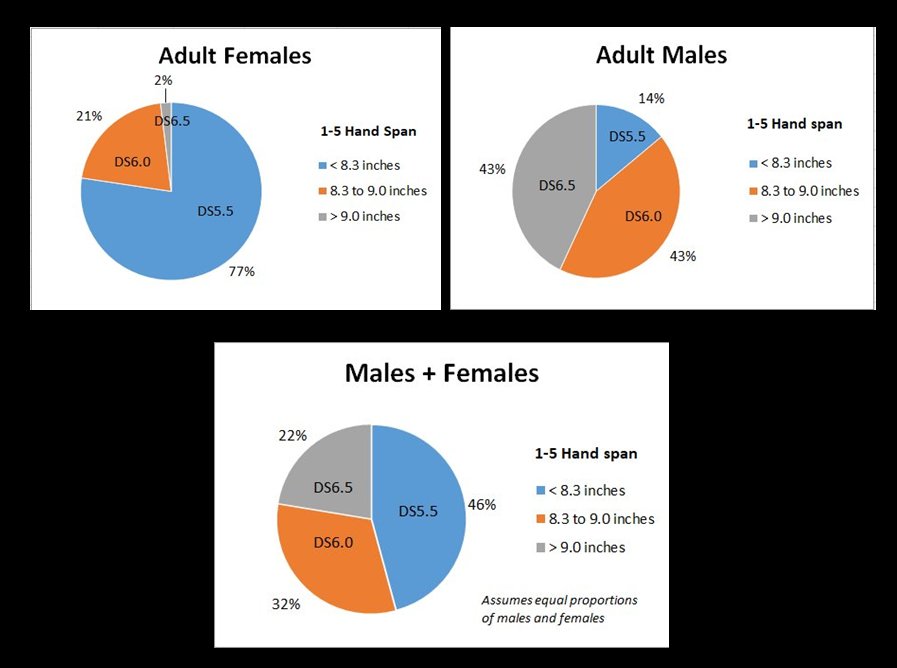Proportions of adult pianists with 'small' versus 'large' hands
The page above: Defining a ‘small hand‘ gives benchmarks separating ‘small’ from ‘large’ hands. Based on this, analysis of the Australian pianist hand span data (Pianists’ hand spans – Australian study) has been used to estimate proportions of pianists with ‘small hands’. These proportions are, of course, in relation to the conventional keyboard.
The analysis showed that virtually all pianists in that survey with 2-5 spans of less than 6.0 inches (15.2 cm) also had 1-5 spans below 8.5 inches (21.6 cm). It therefore follows that estimates of the proportions of pianists with ‘small hands’ can be based on 1-5 spans alone. Accordingly, the proportions of pianists in the following ‘zones’ have been estimated as shown in the table and chart below.
A: Very small – 1-5 span less than 7.6 inches (19.3 cm)
B: Small – 1-5 span from 7.6 to <8.5 inches (19.3 to 21.6 cm)
C: Large – 1-5 span from 8.5 to <9.4 inches (21.6 to <23.9 cm)
D: Very large – 1-5 span of 9.4 inches (23.9 cm) and above.


A smaller study of the hand spans of children indicates that there is a significant overlap between the spans of adult women in Zone A (very small) and those of young children (under 12 years). In other words, a significant proportion of women (nearly one third) have ‘child-sized’ hands. See Pianists’ hand spans – Australian study.
Drawing on the information presented on the previous pages: Hand span versus interval reach and Defining a ‘small hand’, the table below summarises the three ‘levels of comfort’ for hand spans in zones A, B, C and D, as applied to octaves, ninths and tenths. Because being able to play tension-free octaves in all circumstances is much more important than for ninths and tenths, the 8.5 inch (21.6 cm) hand span benchmark has been adopted as being the minimum acceptable for the conventional 6.5 inch (16.5 cm) octave keyboard. Of course, if the pianist only wishes to play pieces with occasional or slow octaves, as in left hand accompaniments, then the ‘minimal comfort’ level can be acceptable.

Hand spans in context
Below is a graphical representation showing ‘small hands’ and ‘large hands’ in context. It draws on broader information based on many pianists’ experiences and perceptions about their hand spans in relation to the conventional keyboard.

'Small' versus 'large' hands when there is a choice of keyboard size
A ‘small hand’ as defined above applies specifically to the task of playing the conventional (6.5 inch octave) keyboard. By transferring to a keyboard with narrower keys, a pianist’s hands become ‘larger’, in effect. For example, when transferring to a DS5.5® keyboard (5.5 inch octave), someone with a 7-inch (17.8 cm) span becomes equivalent to a person with an 8.2 inch (20.8 cm) span on the 6.5 inch keyboard – their effective hand span becomes slightly more than one inch ‘larger’. This adds at least one extra white note to the maximum interval that can be played. For the average 7.9 inch (20.1 cm) female hand span, this means that on the DS5.5® keyboard their hands are at least equivalent to the average male hand span on the 6.5 inch keyboard. It means the difference between being able to play (or not play) fast passages of octaves or large chords with comfort, speed and power, as well as with minimal pain or tension and reduced risk of injury.
‘The female hand is, on average, 15% smaller than the male hand. This statistic is very interesting when one realises that that translates to female hands being generally 7/8 the size of male hands….The conventional keyboard is designed to fit the average large hand. When playing the 7/8 keyboard, it is clear that I am replicating [my husband’s] experience on the conventional keyboard.’
Dr Carol Leone, Chair of Keyboard Studies, Meadows School of the Arts, Southern Methodist University, Dallas, Texas, USA 2003, p 27.
Standardised keyboards are a relatively recent development (See Keyboard history) and the size that we have today is large in a historical context. The 6.5 inch octave keyboard does not suit the vast majority of women and children, as well as a sizable proportion of men, from an ergonomic perspective. Furthermore, there is evidence that pianists have somewhat larger spans than non-pianists. This is to be at least partly due to self-selection, meaning that those with bigger spans (with everything else such as musical ability being equal) are more likely to find piano playing easier and more enjoyable, achieve success at a young age and are therefore encouraged to continue playing.
In a recent study of the attitudes among piano students (where females outnumbered males 3:1) in a US University, 75% said they would like to have bigger hands! This is broadly consistent with the proportion who would be expected to have ‘small hands’ within a group of similar gender mix.
Some great artists of the past – including the legendary Josef Hofmann – used pianos with narrower keys, and composers of the nineteenth century would have been composing and performing on such keyboards. To read about Hofmann’s keyboard, see: Keyboard history.
The table and charts below illustrates how the proportions of pianists with ‘small hands’ can be reduced significantly when they have a choice of keyboard size!


Another way of presenting this information is to consider the ‘ideal’ DS keyboard size that pianists would choose if they were widely available and cost was not an issue. These estimates (see pie charts below) assume the pianist wants access to practically any repertoire, or in other words, not be constrained by hand size.
The boundaries of each group are based on my own judgement, from the evidence base and having seen many pianists play and comment on the issue for the last 10 years, taking into account their hand spans.
It does not take into account other factors like 2-5 spans and finger thickness. If we choose a more realistic benchmark for 2-5 spans so that the pianist can play any 7ths, indications are that a 2-5 span of 6.5 inches (16.5 cm) is required on the conventional keyboard. This would place 64% of males and 28% of females in the ‘large hands’ category. In other words, 36% of males and 72% of females would have ‘small hands’ based solely on the 2-5 benchmark. It is notable that all 12 pianists rated as having ‘international’ standing as soloists in the Australian study had 2-5 spans above 6,5 inches, with most being close to or above 7 inches.
The pie charts above also do not take into account the fact that a sizeable minority of women with very small hands would most likely prefer the DS5.1®, which has a 5.1 inch octave (13.0 cm).
The pie chart for adult males and females combined assumes a 50/50 split between the genders.
Of course, they also do not take children into account!or



